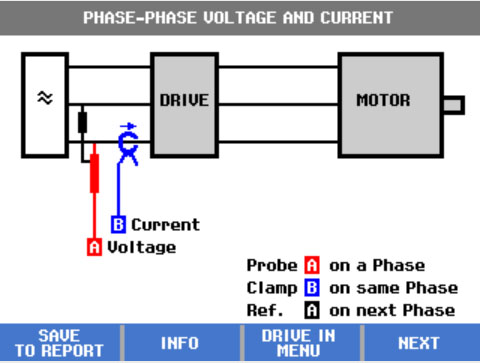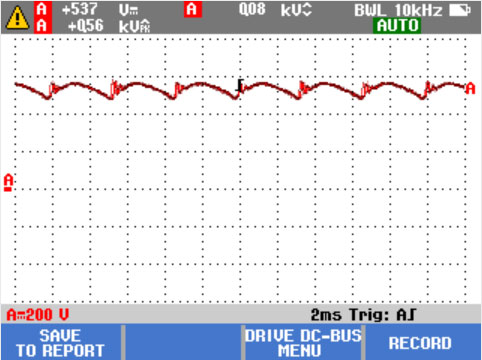Testing the driver output is critical to the normal operation of the motor and can provide clues to problems in the driver circuit.
test
·Determine whether the voltage and current are within the limits. A high output current may heat the current, thereby reducing the insulation life of the stator.
·Check the voltage / frequency ratio (V / Hz) to ensure that it is within the specified limits of the motor. High ratio may overheat the motor; A low ratio will cause the motor to lose torque. Stable frequency and unstable voltage may indicate DC bus problems; Unstable frequencies and stable voltages may indicate switching (IGBT) problems. Unstable frequency and voltage indicate a possible problem with the speed control circuit.
·When checking the driver output, the emphasis is on measuring the voltage frequency ratio (V / F) and voltage modulation. When the measured value of V / F ratio is high, the motor may overheat. When the V / F ratio is low, the connected motor may not be able to provide the required torque on the load, resulting in insufficient execution of the expected process.
·Check voltage modulation using phase to phase measurement. High voltage peaks may damage the motor winding insulation and cause the driver to trip. A voltage peak exceeding 50% of the nominal voltage may cause problems.
·Check the steepness of the switching pulse indicated by the driver reading. The rise time or steepness of the pulse is expressed by the DV / dt reading (the rate of change of voltage over time), which shall be compared with the specified insulation value of the motor.
·Test the switching frequency of phase to DC. Identify whether there is a potential problem with the electronic switch or the grounding, which may indicate a problem when the signal floats up and down.
·The measurement of voltage imbalance is preferably carried out under full load conditions. Voltage unbalance shall not exceed 2%. The voltage imbalance will cause the current imbalance, which will cause the motor winding to overheat. The cause of the imbalance may include a driver circuit failure. If one phase fails, it is called "single-phase operation", which may cause the motor to heat up, fail to start after shutdown, greatly reduce the efficiency, and may damage the motor and the connected load.
·Measure the current unbalance. For three-phase motor, the current unbalance shall not exceed 10%. A large imbalance when the voltage is low may indicate that the motor winding is short circuited or the phase is short circuited to ground. A large imbalance may also cause the driver to trip, the motor temperature to be too high and the winding to be burnt
4. Motor input
It is very important to supply voltage to the input terminals of the motor, and it is also important to select the wiring between the driver and the motor. Incorrect wiring selection can cause damage to the driver and motor due to high voltage peaks. These tests are basically the same as the driver output tests described above.
test
·Check whether the current on the terminal is within the rated value of the motor. Too high a current will cause the motor to overheat and shorten the life of the stator insulation, leading to premature motor failure.
·Voltage modulation helps to identify high voltage peaks to ground that may damage the motor insulation.
·Voltage imbalance will seriously affect the service life of the motor and may be a symptom of inverter failure. This may cause a voltage gap and cause the overload fault protection device to trip.
·Current imbalances may indicate voltage imbalances or driver rectifier problems.
5. Motor shaft voltage
Voltage pulses from the motor driver will couple between the motor stator and the rotor, resulting in voltage on the rotor shaft. When the voltage of the rotor shaft exceeds the insulation voltage of the bearing grease, flashover current (spark) may occur, resulting in pitting and groove corrosion of the motor bearing race. This damage may lead to premature failure of the motor.
test
Measure the voltage between the motor frame and the drive shaft. For example, mda-550 provides a carbon fiber brush probe for this purpose. This test can easily detect the presence of destructive flashover currents, while pulse amplitude measurement and event counting functions allow you to take action before a fault occurs.


